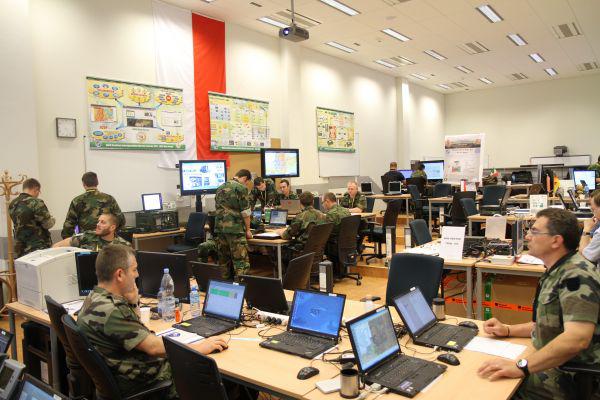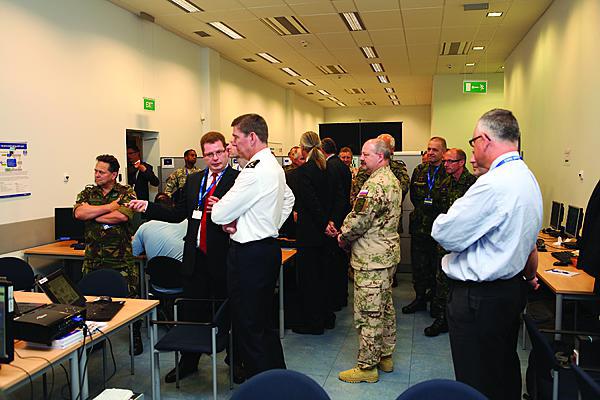Nations Strive for Interoperability
A military exercise designed to refine and improve the way coalition partners share vital information will, for the first time, include the network that is supporting troops in Afghanistan. Scheduled to take place in Poland next month, the event will feature military command and control communications experts from NATO, partner organizations and nations who share the goal of rigorously testing communications interoperability among coalition members. But one of the largest of those partners, the United States, is not taking a leading role in one of the newest, and most challenging areas, cybersecurity.
The Coalition Warrior Interoperability Exploration, Experimentation and Examination Exercise (CWIX) is held annually by NATO’s Military Committee and overseen by NATO’s office of Allied Command Transformation (ACT) based in Norfolk, Virginia. This year’s exercise will take place June 3 to 20, with its primary execution site at the Joint Forces Training Center in Bydgosczc, Poland.
The exercise is noted for having evolved almost constantly along with improvements and new developments in technology over the last decade. Kell Hvolbol, deputy director of the CWIX, ACT, explains that while the primary site for the CWIX exercise is in Poland, as many as six large coalition nations will connect to the CWIX backbone network through remote links, incorporating their own computing resources back home into the interoperability scenario. “They basically leave their whole server farm at home, and they control all of their testing from the main execution site in Poland. One of the advantages is that you have to move less equipment,” Hvolbol explains. A central location for the exercise also speeds troubleshooting in the event that an interoperability problem comes up. “By having all these engineers in the same room, you can go and grab an engineer from your partner nation, drag him down to your screen, and say, ‘This is what it comes in like, and you have to do something about it,’” he describes.
The CWIX provides an environment in which NATO nations, partner nations and NATO agencies can verify the interoperability of their current command and control systems. Even though most systems are designed and built to generally accepted standards, it is not unusual for the military services/agencies drafting the specifications or manufacturers to interpret those standards differently, Hvolbol explains. At the most basic level of interoperability verification, he adds, one coalition partner can send a data stream to another and walk across the room to ensure the information is being correctly transmitted and displayed. If it isn’t, the participants readily can begin the task of determining how to resolve the problems.
Over the past several years, coalition forces have used the CWIX continually to refine the Afghan Mission Network (AMN), an information-sharing environment operated by NATO and designed to facilitate communication among International Security Assistance Force (ISAF) coalition members. Hvolbol says that as in past years, there will be a live connection between the CWIX backbone in Poland and the AMN in Afghanistan, but this year that link is expected to expand the number of remote coalition sites that will participate in real time in the CWIX. There have been as many as eight remote locations in past years. “This year, I believe the number is somewhere around 15 or 16 remote sites that are going to be playing at the same time. Ninety percent of the Canadian effort is going to be played from Canada, the U.S. Navy has a big lab in San Diego and these guys will be playing from there,” Hvolbol says. Interoperability testing also is being planned within the CWIX for the Future Mission Network, the architecture of which is being designed at this time.
The CWIX is built around a scenario, or as Hvolbol calls it, a data simulation, the details of which remain classified until the exercise in June. “When you do all this testing, you have to play somewhere in the world. NATO has developed its own scenario that runs in the background, and we have people who react from an operational point of view to events that are happening.” Participants are provided with voluminous detail in “country books” about the fictional nations that are the setting for scenario incidents. Geospatial information, based on real-world geography, also is included. A large data set forms the basis for activities within the scenario. Smaller vignettes describing seemingly standalone incidents, such as a bridge being blown up, can be inserted at random to provide unexpected events that must be dealt with by participants. In addition, a dose of realism can be injected in the scenario in the form of background clutter, data that may or may not be related to the situation at hand but that must be accommodated by the systems that are being tested.
Cybersecurity is another focus area that will be examined during this year’s CWIX. Despite the importance of cybersecurity, last year’s exercise marked the first time that cyberdefense was a major part of the interoperability testing. Mindful that cybersecurity has recently become a priority with the U.S. military, Hvolbol says that much of the leadership within the CWIX for cyberdefense has come from other partners. “The Finns are really strong in that area. We’ve also seen good participation from the Polish.” U.S. participation in CWIX 2013 cyberdefense activities is “not present,” Hvolbol admits.
Ironically, one of the challenges the CWIX planners face in the realm of cyberdefense is recruiting challenging adversaries. “The problem is finding good attackers, because if you don’t have good attackers, then it’s hard to find ways to protect yourself in the context of the exercise,” says Hvolbol.
One of the hallmarks of the CWIX is the practical, problem-solving mindset that drives the interoperability testing regimen of the exercise. For example, Hvolbol recalls that seven years ago, in the early days of the fighting in Afghanistan, numerous reports surfaced regarding blue-on-blue attacks that involved coalition forces inadvertently calling in aerial and ground bombardment against their own coalition partners. In August 2007, friendly fire killed three British soldiers when U.S. F-15s responded to a British call for help.
Generally, this problem was linked to an inadequate and sometimes fatal lack of precise information regarding the location of forces within an operational area. As casualties mounted, Hvolbol continues, “the nations said ‘enough is enough. We need to find a way to transfer this data easily so we can tell where all the good guys are.’ That was an effort that took about three to four years, where one nation would go home and start changing their system. They came up with a protocol for this that has been adopted as an international standard, but all the preliminary work was done during CWIX,” Hvolbol says. The protocol matured, and NATO forces in Afghanistan implemented it, resulting in a decline in the number of friendly fire incidents among coalition forces.
The format of the CWIX exercise dates back to 2000, when the first interoperability exercises took place within NATO’s Supreme Headquarters Allied Powers Europe (SHAPE) facility in Mons, Belgium. “Back then we probably had six or seven nations, and less than 30 capabilities that were tested,” explains Hvolbol. The primary concern then was for the proper formatting and transmission of text messages and the equipment for geospatial mapping and displays had just begun to appear. In addition, the first systems featuring graphical Web interfaces had just been introduced, along with the ability to display high-resolution maps.
While industry plays a role in most coalition exercises of this type, Hvolbol is emphatic in explaining the limited role that industry has in the CWIX. “CWIX is not a trade show. This is not a place where industry can come and show off all their good stuff and hope they can make a lot of money,” he says. “Industry will always come representing a nation, or a military command, or a military agency.” An Exercise Specification Conference is expected to be convened sometime in September, including exercise participants and NATO military leaders to evaluate the findings from CWIX 2013 and begin the planning for CWIX 2014.
During the past decade, the CWIX was conducted in parallel with the U.S. Defense Department’s Coalition Warrior Interoperability Demonstration (CWID), a program sponsored by the U.S. Joint Chiefs of Staff. The CWID program, which began life in 1994 as the Joint Warrior Interoperability Demonstration, also sought to serve as a development and testing environment for command and control communications systems and included traditional coalition partners as well as NATO.
But in the early 2000s, the two programs began to look at the interoperability exercises in very different ways, Hvolbol says, and one involved industry participation. “Fifteen years ago, it was a way for industry to show technology for warfighters, and that was how it was set up,” he observes. Testing and interoperability took a back seat to what he calls “showing off technology.”
In addition, the priorities of the CWID began to conflict with other operational realities for the Europeans. “Because of the way acquisitions work in NATO, it doesn’t matter if you convince the warfighter to buy ‘system B.’ When it comes to purchases based on requirements, NATO will always pick the lowest confirmed bidder,” Hvolbol states. “NATO representatives realized, “as the years passed, the only thing we had in common was that [the two events] were taking place at the same time frame every year. Because we were running our own show, and the U.S. tried to run NATO’s program, we went our own way and moved the NATO program to Norway, and then more nations began to use this event as part of their system development cycles,” he explains.
As for the CWID, Hvolbol notes that the U.S. industry-based interoperability program was overtaken by other ways to demonstrate C2 systems to warfighters independent of demonstration events and was placed on hiatus by the Defense Department several years ago. He says that as far as he knows, there has been no word on when the CWID might resume.






Comments